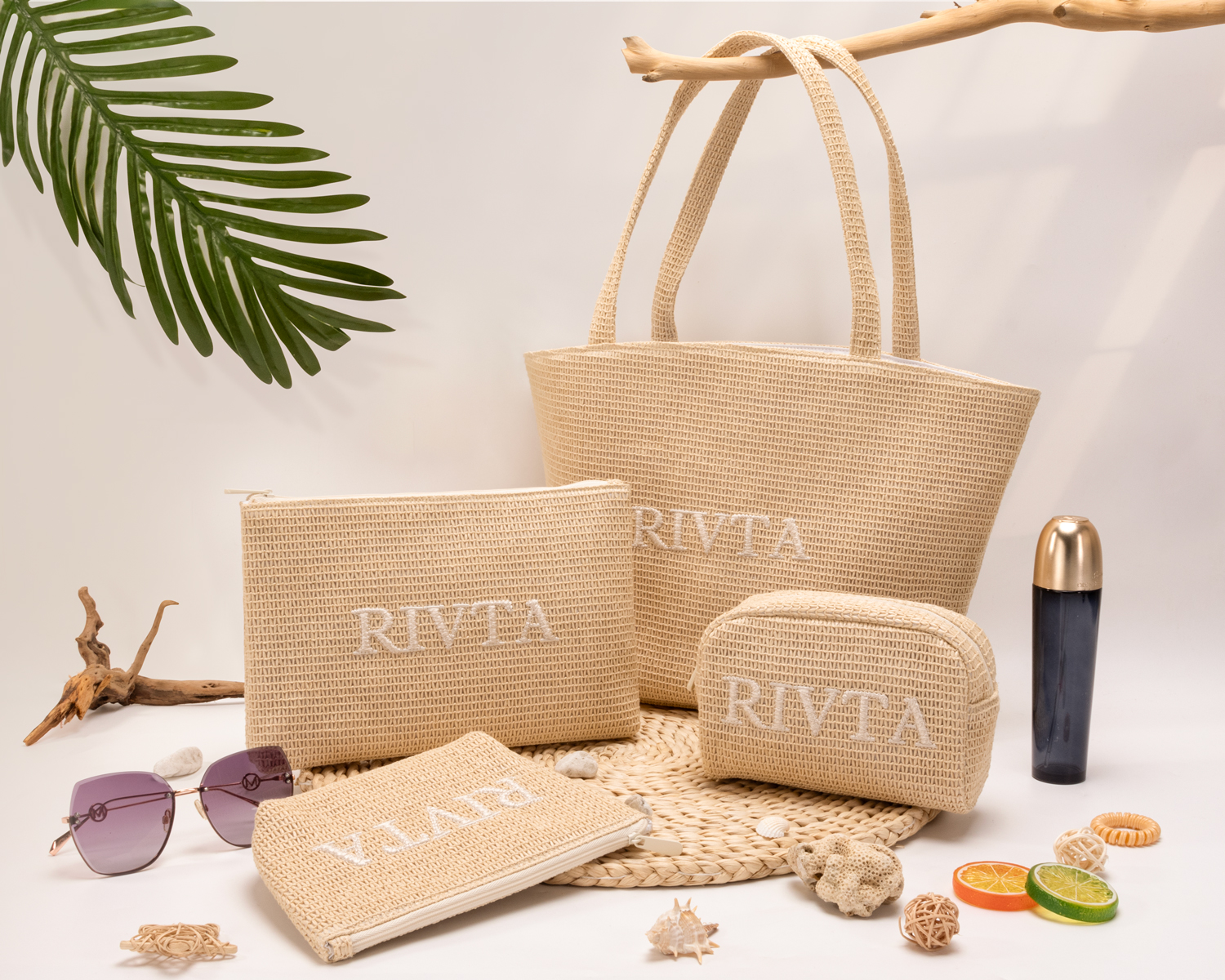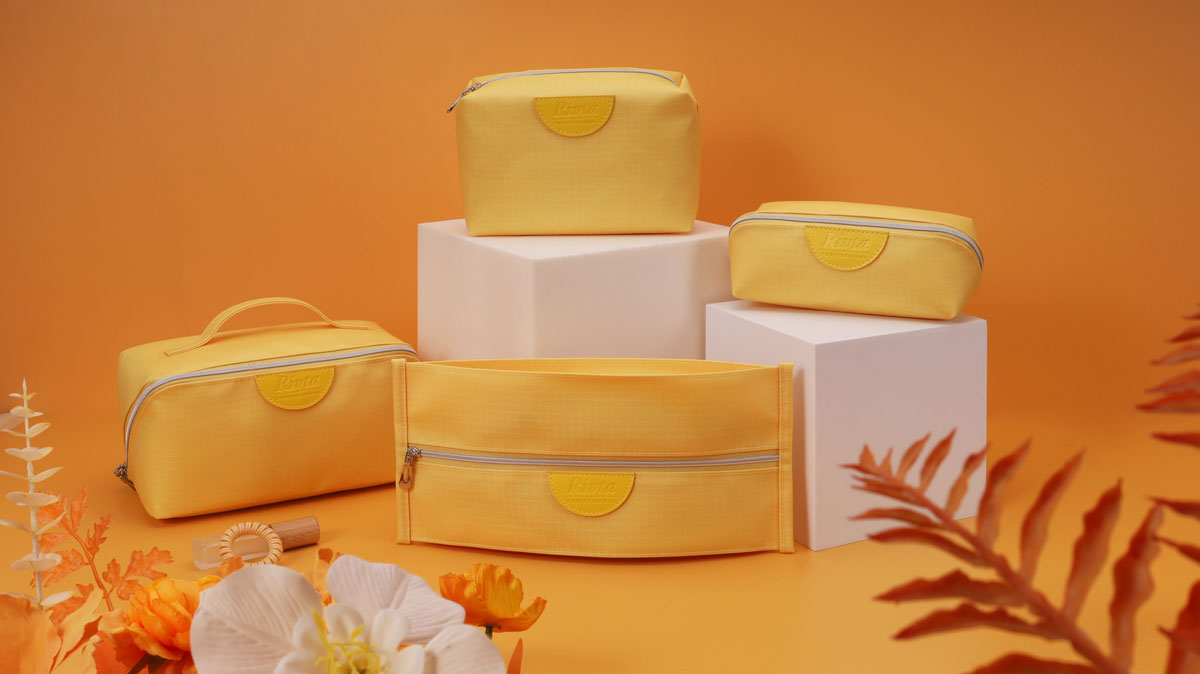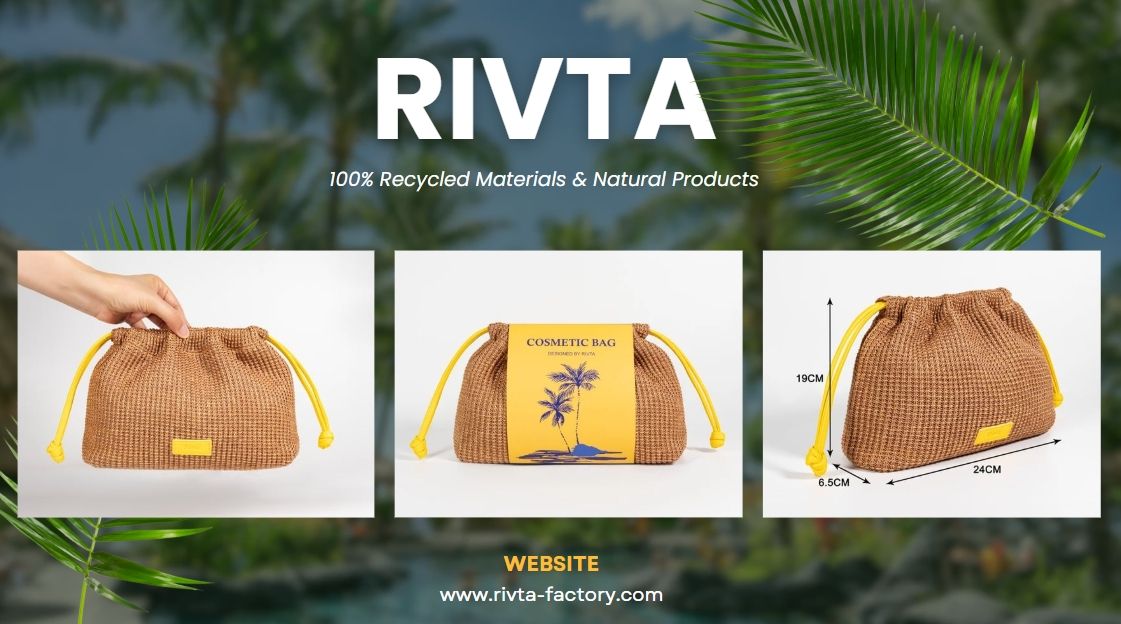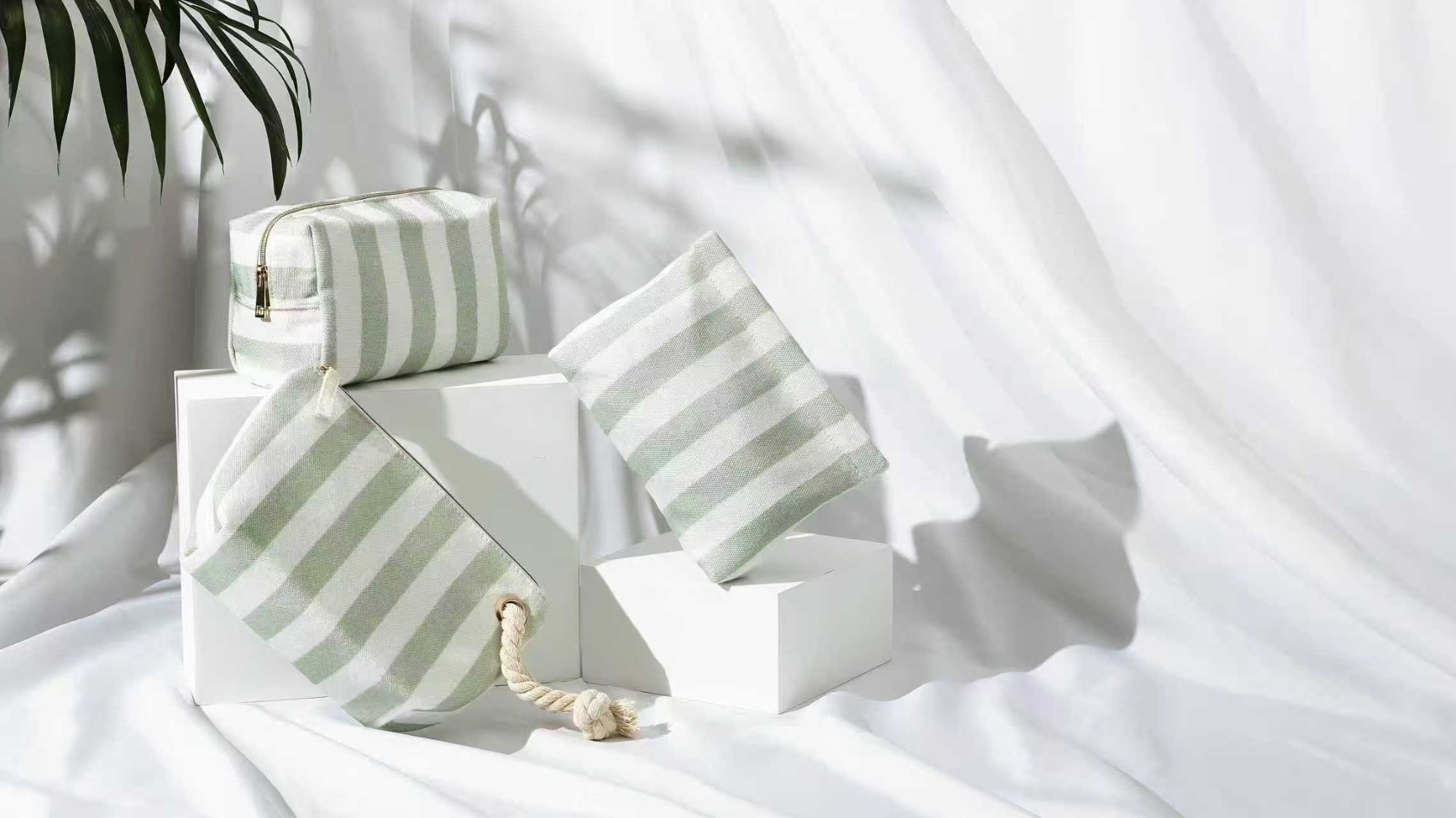A Comprehensive Guide to Choosing the Best Fabric for Custom Scrunchies

As a leading manufacturer of eco-friendly products, Rivta specializes in sustainable solutions like cosmetic bags, jewelry boxes, toiletry bags, and custom accessories, all crafted at our state-of-the-art factory. Our custom scrunchies are designed to meet the needs of CEOs, founders, product development directors, and buyers in industries such as skincare, beauty, hair care, outdoor, and maternal/infant products. Choosing the right fabric for custom scrunchies is critical to creating a product that enhances hair health, reflects brand aesthetics, and aligns with sustainability goals. This guide explores the top fabric options for wholesale custom scrunchies, highlighting their benefits for hair care, durability, customization, and environmental impact, while showcasing Rivta’s commitment to eco-friendly manufacturing.
1.Introduction: The Evolution of Scrunchies and the Importance of Fabric Selection
Scrunchies have evolved significantly since their debut in the 1980s. Originally a simple hair accessory invented by Rommy Revson, they quickly became a cultural phenomenon, embraced for their practicality and playful style. After a decline in the early 2000s, scrunchies made a triumphant return in the 2010s, driven by nostalgia and a renewed focus on hair health. Today, they are a staple in both fashion and function, valued for their ability to hold hair securely without causing damage—a stark contrast to traditional elastic bands that can snag and break strands.
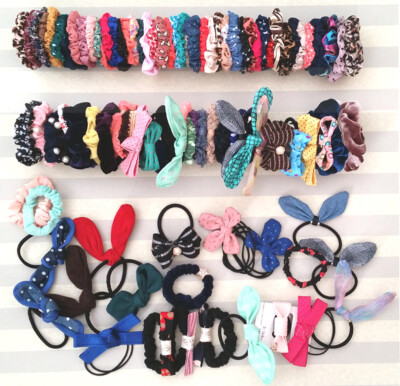
For B2B clients, particularly those in beauty, hair care, and maternal industries, the fabric choice for custom scrunchies is a strategic decision that impacts product performance, customer satisfaction, and brand reputation. The fabric you select affects several key aspects:
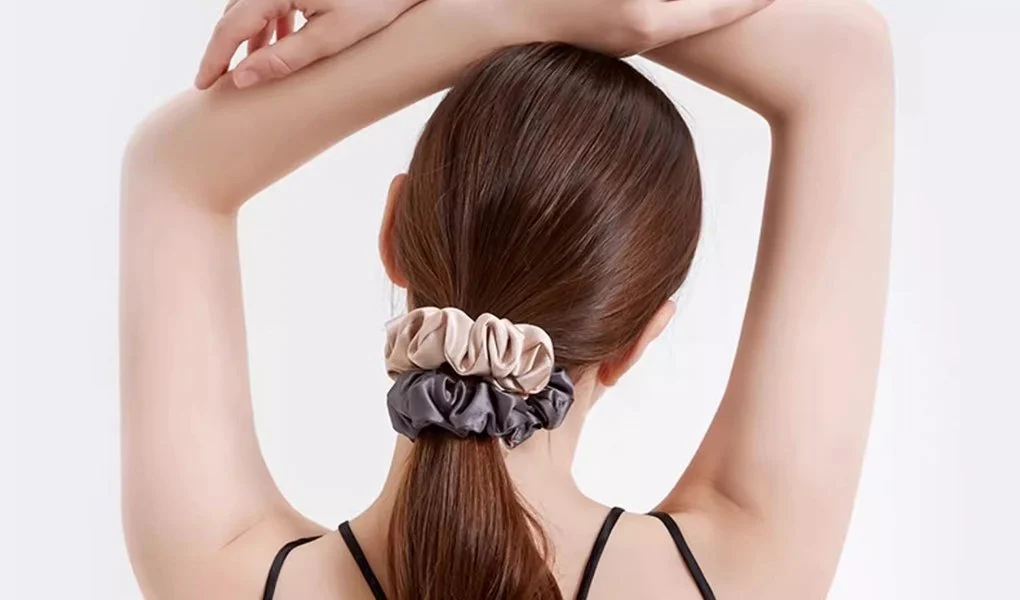
- Hair Health:Smooth fabrics like silk and satin reduce friction, preventing breakage and frizz—essential for brands targeting consumers with curly, wavy, or damaged hair.
- Aesthetics and Branding:Fabrics such as velvet or sheer organza create distinct visual identities, while customization options like printing or embroidery enhance brand visibility in promotional campaigns.
- Durability: Durable fabrics like cotton and polyester ensure scrunchies withstand frequent use, appealing to practical buyers seeking long-lasting products.
- Sustainability: Eco-friendly fabrics align with the growing consumer demand for green products. A 2025 market report noted a 15% rise in sustainable accessory sales, underscoring the importance of environmentally conscious choices.
- Customization: Fabrics that support dyeing, printing, or embroidery are ideal for creating branded scrunchies that stand out in competitive markets.
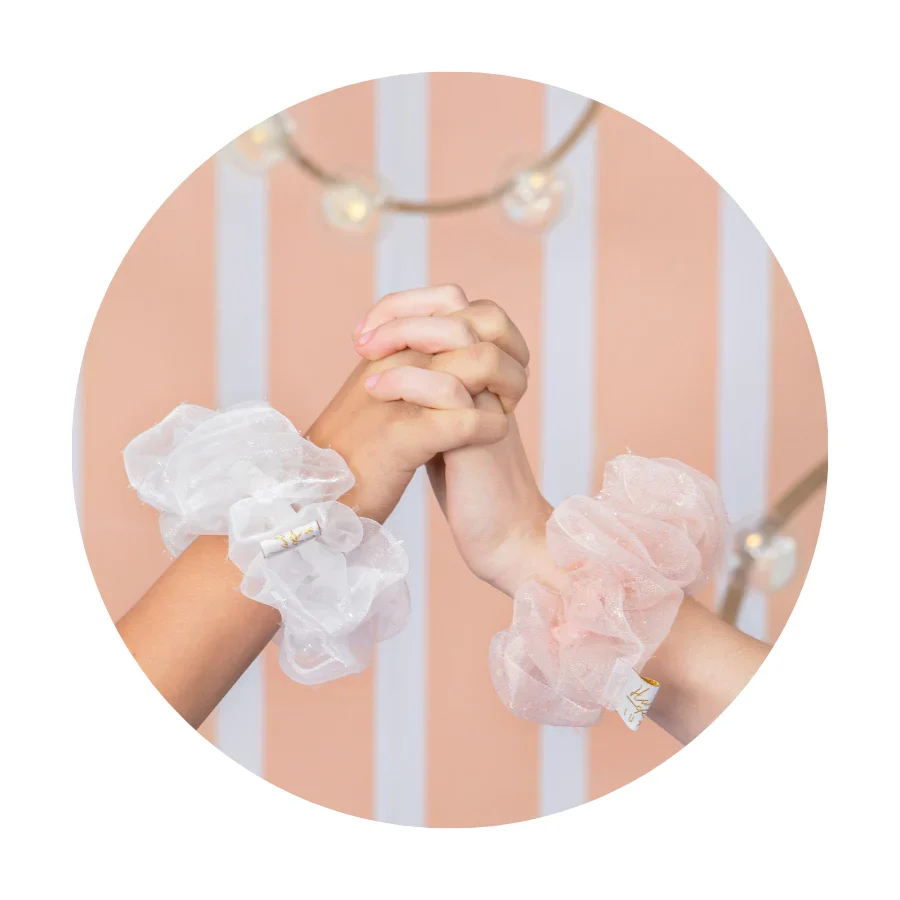
For brands partnering with Rivta, selecting the right fabric is an opportunity to create high-quality, eco-conscious scrunchies that resonate with environmentally aware consumers and strengthen B2B relationships. As a factory committed to sustainable manufacturing, Rivta offers a range of fabrics that balance performance, aesthetics, and environmental responsibility. This guide will help you navigate the options, understand their applications, and leverage Rivta’s expertise for your next wholesale order.
2.Top Fabric Options for Custom Scrunchies: A Detailed Breakdown
Choosing the best fabric for custom scrunchies requires balancing hair care, aesthetics, durability, and sustainability. Below is a comprehensive overview of the most suitable fabrics, supported by their properties, applications, and customization potential.
| FABRIC | PROPERTIES | BEST FOR | SUSTAINABILITY | CUSTOMIZATION |
|---|---|---|---|---|
| SILK (MULBERRY, VEGAN) | SMOOTH, REDUCES FRICTION BY 50%, PREVENTS BREAKAGE | DRY/DAMAGED HAIR, LUXURY BRANDING | VEGAN SILK (BAMBOO-BASED) IS ECO-FRIENDLY | DYEABLE, EMBROIDERY NEEDS CARE |
| SATIN | GLOSSY, LIGHTWEIGHT, REDUCES FRIZZ | CURLY/WAVY HAIR, NIGHTTIME WEAR | NATURAL OR RECYCLED SATIN | EXCELLENT FOR DYEING |
| COTTON | BREATHABLE, SOFT, HYPOALLERGENIC | DAILY WEAR, SENSITIVE SKIN | ORGANIC COTTON IS SUSTAINABLE | IDEAL FOR PRINTING, EMBROIDERY |
| VELVET | PLUSH, DURABLE, STRONG GRIP | ACTIVE WEAR, THIN HAIR | COTTON OR RECYCLED VELVET | BEST FOR SIMPLE DESIGNS |
| BAMBOO | SOFT, MOISTURE-WICKING, OEKO-TEX® CERTIFIED | ECO-CONSCIOUS CONSUMERS | HIGHLY SUSTAINABLE, BIODEGRADABLE | DYEABLE, EMBROIDERY-FRIENDLY |
| POLYESTER | DURABLE, WRINKLE-RESISTANT, COST-EFFECTIVE | BUDGET PROJECTS, MASS PRODUCTION | RECYCLED POLYESTER IS ECO-FRIENDLY | EASY TO DYE, PRINT |
| LINEN | DURABLE, BREATHABLE, RUSTIC CHARM | HOT CLIMATES, NATURAL LOOKS | ECO-FRIENDLY, LOW WATER USE | GOOD FOR DYEING, MAY FRAY SLIGHTLY |
| TAFFETA | LIGHTWEIGHT, ELEGANT, SLIGHT SHEEN | FORMAL EVENTS | RECYCLED TAFFETA IS SUSTAINABLE | GREAT FOR EMBROIDERY |
| DENIM | STURDY, CASUAL, DURABLE | EVERYDAY WEAR, EDGY STYLE | ORGANIC/RECYCLED DENIM IS GREENER | DYEABLE, THICKER FOR EMBROIDERY |
| SHEER/ORGANZA | LIGHTWEIGHT, AIRY, DELICATE | FASHION STATEMENTS | SUSTAINABLE IF ORGANIC/RECYCLED | BEST FOR SUBTLE DESIGNS |
2.1 Silk (Mulberry and Vegan Silk)
Silk is the gold standard for hair-friendly fabrics. Mulberry silk, derived from silkworms fed exclusively on mulberry leaves, is prized for its smooth texture and durability. According to Fii Beauty, it reduces friction by up to 50%, minimizing breakage and split ends—a key selling point for brands targeting consumers with dry or damaged hair. Vegan silk, often made from bamboo or eucalyptus, offers similar benefits without animal involvement, aligning with Rivta’s eco-friendly ethos. While silk scrunchies elevate luxury branding, they require careful handling during customization, as embroidery can snag the delicate fibers.
- Use Case: Luxury hair care brands or high-end promotional campaigns.
- Customization Tip: Opt for dyeing or subtle embroidery to maintain the fabric’s integrity.
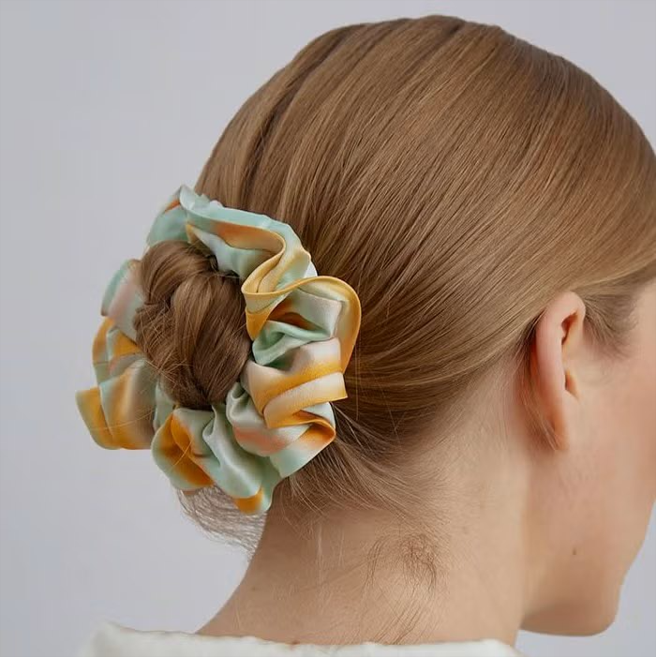
2.2 Satin
Satin’s glossy finish and lightweight texture make it a hair-health hero, particularly for curly or wavy hair types. XXL Scrunchie & CO highlights its ability to maintain curl shape and reduce frizz, making it a popular choice for nighttime wear or delicate hairstyles. Available in natural or recycled forms, satin enhances sustainability while offering a smooth surface perfect for dyeing and embroidery. For brands aiming to balance affordability, satin is a versatile option.
- Use Case: Beauty brands focused on hair health or nighttime care routines.
- Customization Tip: Use satin for vibrant prints or intricate embroidery designs.
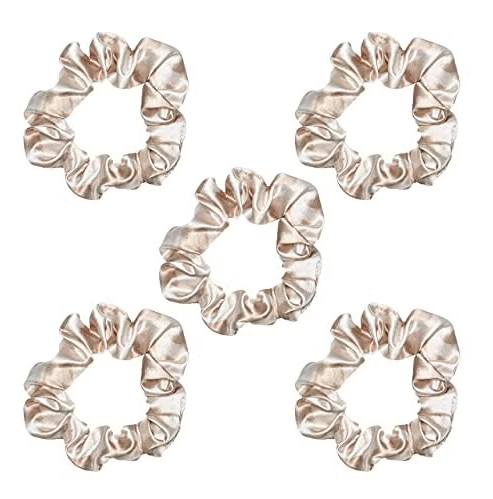
2.3 Cotton
Cotton is a classic choice, valued for its breathability, softness, and hypoallergenic properties. Provincial Fabric House notes its versatility and lustrous tones, making it a timeless option for daily wear and sensitive skin. Organic cotton, a staple at Rivta, is grown without pesticides, reducing environmental impact and supporting ethical farming practices. Its tight weave ensures clear printing and embroidery, making it a go-to for wholesale customization.
- Use Case: Everyday scrunchies or brands targeting sensitive skin.
- Customization Tip: Cotton’s texture is ideal for bold prints and detailed embroidery.
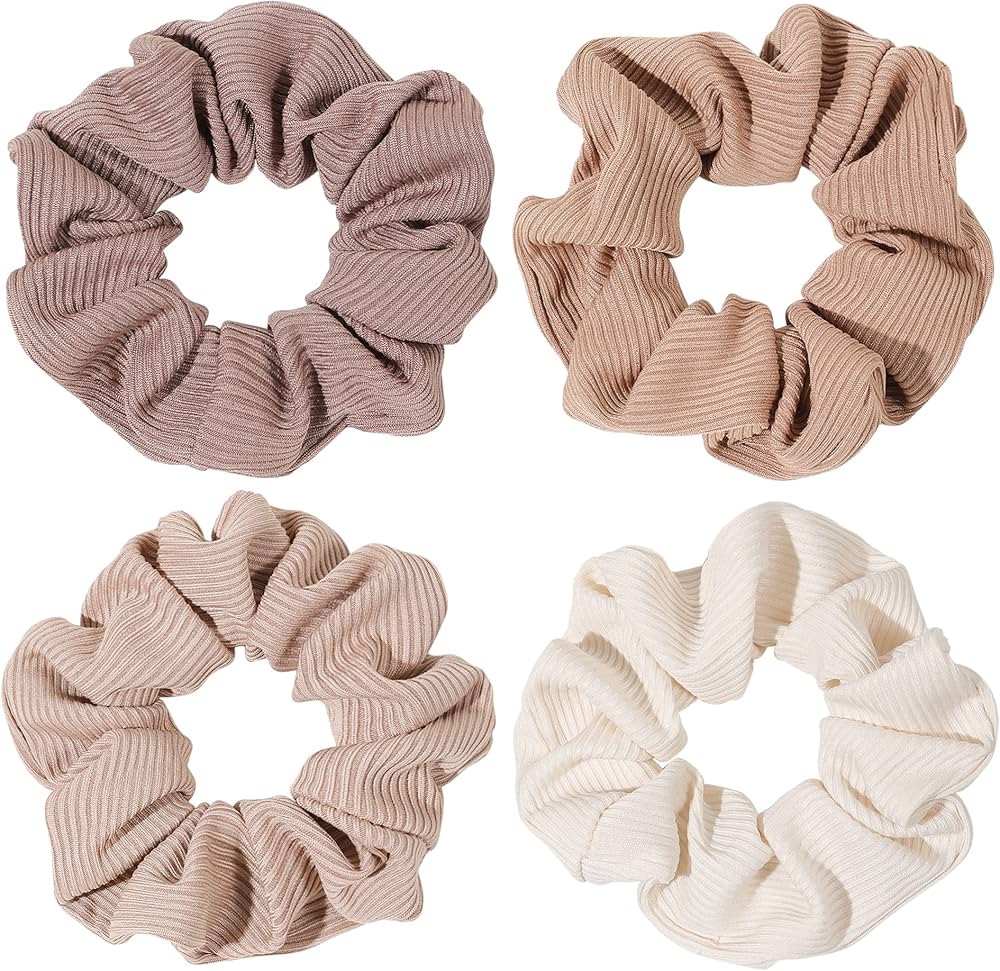
2.4 Velvet
Velvet brings a plush texture and strong grip to the table, making it ideal for active wear and thin hair. Fii Beauty emphasizes its durability and volume-adding properties, which appeal to consumers needing a secure hold. Cotton or recycled velvet enhances sustainability, and while it’s less suited for intricate embroidery, it excels for bold, simple designs in promotional campaigns.
- Use Case: Outdoor or activewear brands.
- Customization Tip: Use velvet for minimalist logos or monograms.

2.5 Bamboo
Bamboo fabric is soft, smooth, and sustainable, with natural moisture-wicking properties that make it perfect for active lifestyles. Simply Organic Bamboo highlights its OEKO-TEX® certification, ensuring no harmful chemicals are used in production. Bamboo scrunchies are biodegradable and gentle on hair, making them a top choice for Rivta’s eco-conscious clients. They’re dyeable and embroidery-friendly, offering versatility for branding.
- Use Case: Eco-friendly brands or hair care products.
- Customization Tip: Bamboo’s smooth surface works well for both dyeing and embroidery.
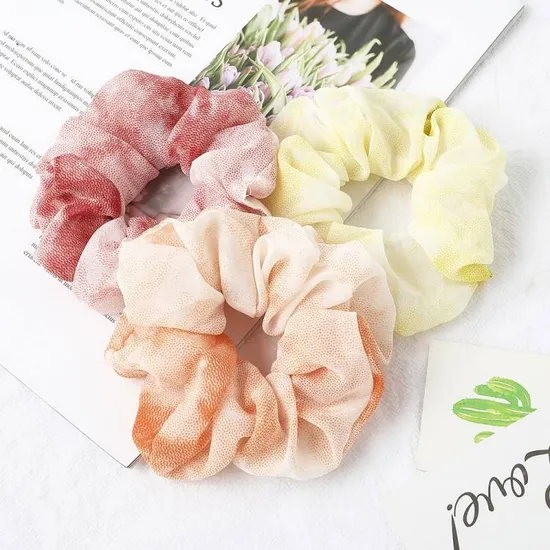
2.6 Polyester
Polyester is a workhorse fabric—durable, wrinkle-resistant, and cost-effective. Fabric Wholesale Direct notes its strength and pattern versatility, which are essential for large-scale orders. Recycled polyester, used by Rivta, reduces environmental impact by repurposing plastic waste, making it a practical choice for wholesale scrunchies. It’s easy to dye and print, supporting vibrant branding.
- Use Case: Budget-conscious projects or promotional giveaways.
- Customization Tip: Polyester’s resilience makes it perfect for complex prints.
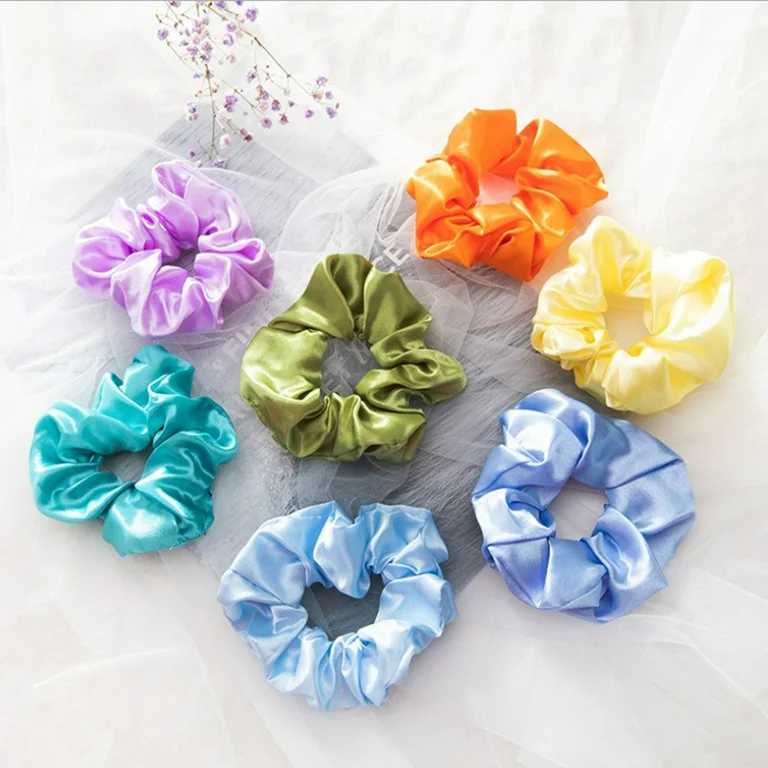
Additional Fabrics for Niche Applications
- Linen: Durable and breathable, with a rustic charm, ideal for hot climates (Provincial Fabric House).
- Taffeta:Lightweight and elegant, perfect for formal events and embroidery (Provincial Fabric House).
- Denim:Sturdy and casual, offering a unique aesthetic for everyday wear (XXL Scrunchie & CO).
- Sheer/Organza:Lightweight and airy, adding a delicate touch for fashion-forward designs (XXL Scrunchie & CO).
These fabrics cater to specific branding needs, such as formal events or casual, edgy styles, allowing brands to diversify their scrunchie offerings and appeal to niche markets.
3.Rivta’s Sustainable Fabric Solutions: A Commitment to Eco-Friendly Manufacturing
Sustainability isn’t just a buzzword at Rivta—it’s the foundation of our manufacturing process. As a factory dedicated to eco-friendly production, we prioritize fabrics that minimize environmental impact while delivering high-quality performance for B2B clients. Our custom scrunchies are crafted with:
- Bamboo: Sourced from renewable plants, bamboo is soft, biodegradable, and OEKO-TEX® certified. Its rapid growth cycle—up to three feet per day—requires minimal water and no pesticides, making it one of the most sustainable fabrics available. Bamboo’s moisture-wicking properties also make it ideal for active wear.
- Organic Cotton: Grown without synthetic pesticides or fertilizers, organic cotton supports biodiversity and reduces soil and water contamination. It’s breathable and hypoallergenic, perfect
- Recycled Polyester: Made from post-consumer plastic bottles, recycled polyester conserves resources and reduces landfill waste. A 2023 textile study found it requires 59% less energy to produce than virgin polyester, offering a durable, cost-effective option for wholesale production.
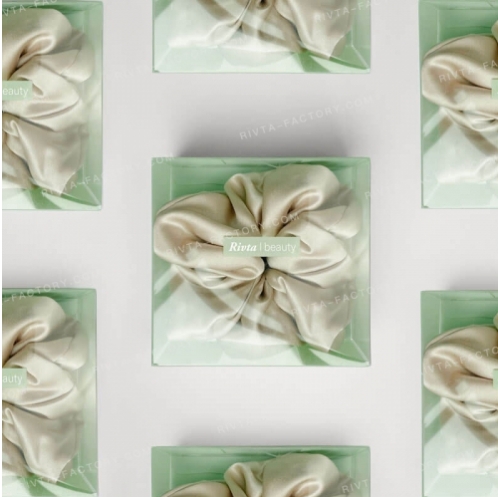
Rivta’s fabrics are backed by certifications like Fair Trade and Organic, ensuring transparency and ethical practices across our supply chain. A 2024 sustainability audit revealed that Rivta’s operations cut carbon emissions by 30% compared to industry averages, providing measurable environmental benefits for our clients. Our factory’s expertise in custom manufacturing allows us to tailor scrunchies to your brand’s aesthetic and sustainability goals, from vibrant prints to eco-conscious materials.
For brands aiming to stand out in promotional campaigns, Rivta’s sustainable fabrics offer a competitive edge. A 2025 consumer survey found that 68% of beauty buyers prefer brands with eco-certifications, a trend that’s only growing. By choosing Rivta’s fabrics, you align your brand with this demand while ensuring high-quality, durable products that appeal to eco-conscious consumers.
4.Customization Techniques for Branded Scrunchies
Customization transforms scrunchies into powerful branding tools. Rivta’s factory offers advanced techniques to ensure your designs are executed with precision and sustainability in mind:
- Printing: Ideal for fabrics like cotton, satin, and polyester, printing allows for vibrant, detailed designs. Digital printing, used by Rivta, employs water-based inks that reduce environmental impact compared to traditional methods, making it an eco-friendly choice for large orders.
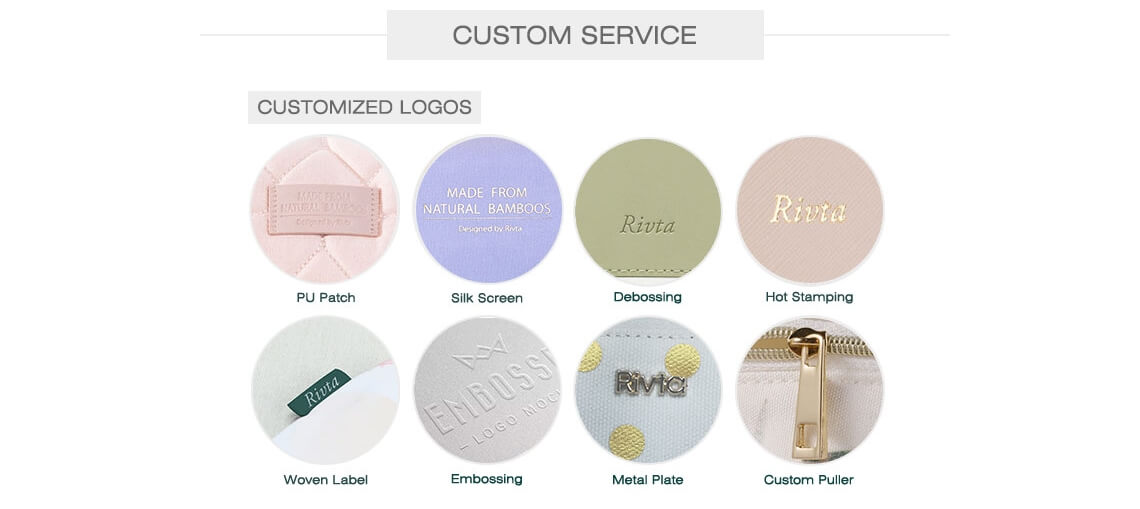
- Embroidery: Best for thicker fabrics like cotton, velvet, and denim, embroidery adds a tactile, premium feel. Rivta uses sustainable threads made from recycled materials, ensuring eco-conscious production without compromising quality.
- Dyeing: Fabrics like silk, bamboo, and linen take dye exceptionally well, allowing for custom color palettes that match your brand’s aesthetic. Rivta’s dyeing process uses low-impact dyes to minimize water usage and pollution.
When customizing scrunchies, consider these factors:
- Fabric Texture: Tight-weave fabrics like cotton ensure clear, crisp prints. For embroidery, test thicker fabrics like denim to ensure the design holds without distortion.
- Color Fastness: Rivta’s dyeing process ensures colors remain vibrant after washing, crucial for maintaining brand consistency across product lines.
- Elastic Pairing: The elastic inside a scrunchie must complement the fabric’s stretch and weight. Rivta uses high-quality, durable elastics—often sourced from recycled materials—that ensure comfort and longevity.
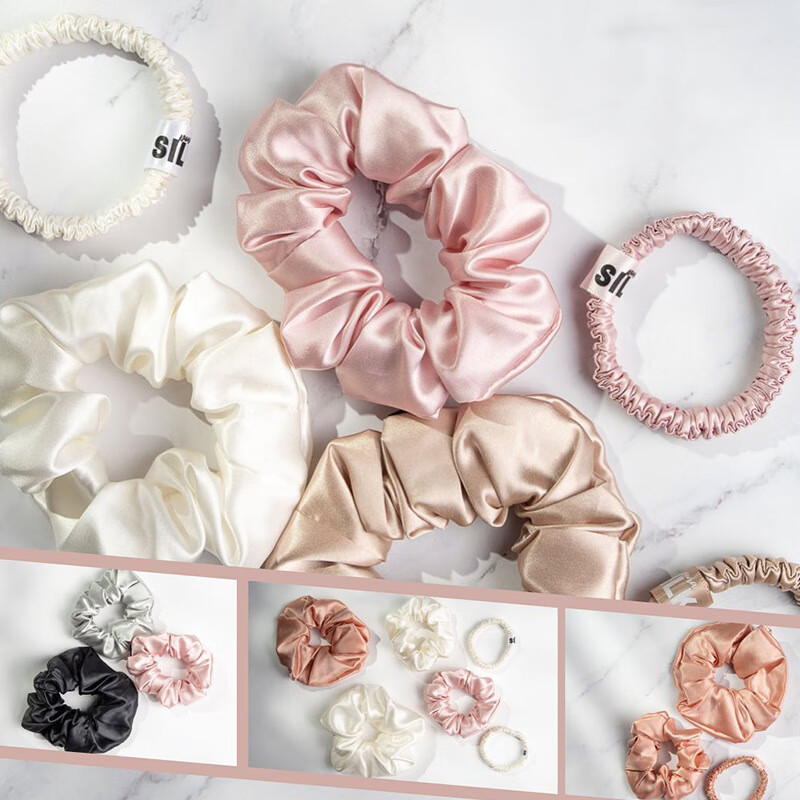
For brands new to scrunchie production, starting with cotton is recommended due to its ease of use and customization potential, as noted by Martha Stewart. Using fabric scraps from other projects can also reduce waste and create unique, patchwork designs, supporting Rivta’s zero-waste initiatives. Whether you’re producing 100 or 10,000 scrunchies, Rivta’s factory ensures every piece meets your specifications.
5.Practical Tips and Considerations for Choosing Fabrics
To create custom scrunchies that meet your brand’s needs and resonate with your target audience, consider these practical tips and potential challenges:
5.1Practical Tips
- Hair Type:
- For fine or damaged hair, choose silk or bamboo for their smoothness and reduced friction.
- For thicker hair, velvet or cotton provide better grip and durability.
- Occasion:
- Use taffeta or sheer for formal events or luxury branding.
- Opt for denim or cotton for casual, everyday wear or outdoor activities.
- Customization:
- Use tight-weave fabrics like cotton for clear, detailed prints.
- For embroidery, select fabrics with enough thickness, such as velvet or denim, to support the design.
- Rivta's factory offers advanced printing and embroidery techniques to ensure precise branding.
- Care Instruction:
- Silk and satin require gentle washing to maintain their smoothness—recommend hand-washing to customers.
- Polyester and cotton are low-maintenance and can withstand machine washing, ideal for practical use.
- Provide care instructions to end-users to extend the scrunchie's lifespan and maintain its quality.
- Sustainability:
- Prioritize bamboo, organic cotton, or recycled polyester to align with eco-conscious consumer trends.
- Rivta's wholesale options ensure cost-effective, sustainable production for large orders.
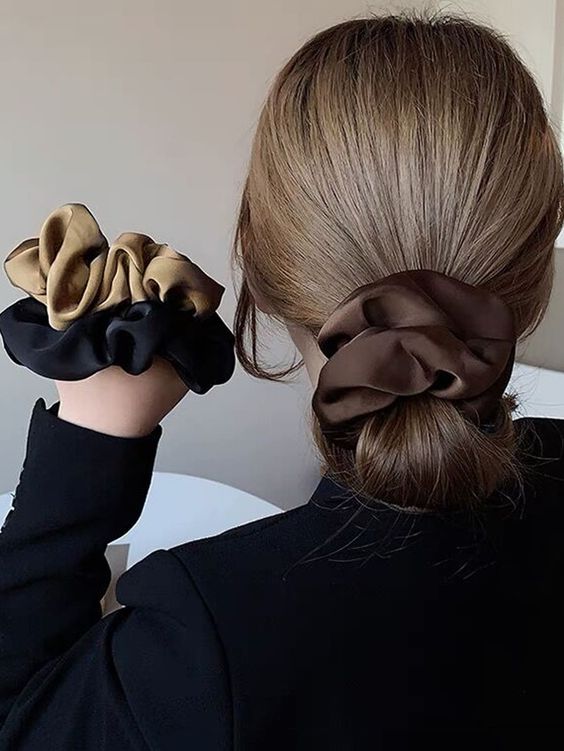
5.2 Challenges and Considerations
- Cost:
- Premium fabrics like silk and high-quality satin come with higher price tags. Bamboo and organic cotton offer affordable, eco-friendly alternatives that still deliver luxury and sustainability.
- Rivta's wholesale pricing ensures cost-effectiveness for bulk orders, making sustainable fabrics accessible for large-scale campaigns.
- Production:
- Fabrics like linen may fray during production. Rivta's factory uses overlock stitching to prevent this, ensuring clean edges and durability.
- Velvet requires careful handling to maintain its plush texture. Rivta's experienced team ensures velvet scrunchies are produced with precision, preserving their luxurious feel.
- Sustainability:
- Verify supplier certifications like OEKO-TEX® to ensure eco-claims. Rivta's transparent supply chain guarantees ethical sourcing and sustainable production practices.
- For brands prioritizing carbon neutrality, Rivta's operations are designed to minimize environmental impact, with a 30% reduction in carbon emissions compared to industry standards.
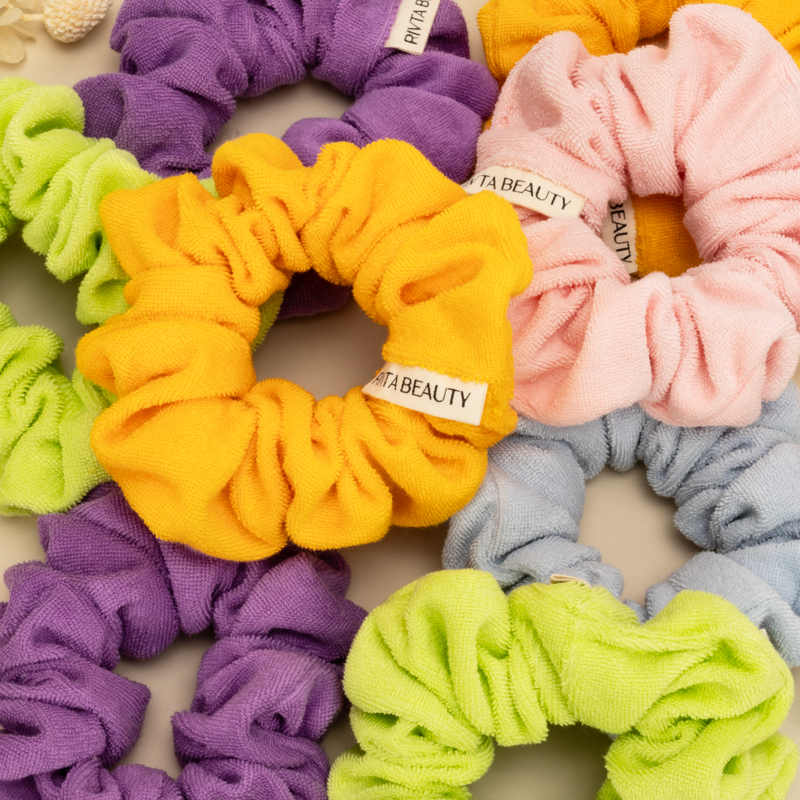
For brands looking to create a cohesive product line, consider offering scrunchies in multiple fabrics to cater to different customer needs. For example, a hair care brand could offer silk scrunchies for nighttime use and cotton scrunchies for daily wear, both branded with the company logo. Rivta’s expertise ensures these challenges are addressed, delivering scrunchies that meet your quality and sustainability goals.
6.Conclusion: Elevate Your Brand with Rivta’s Custom Scrunchies
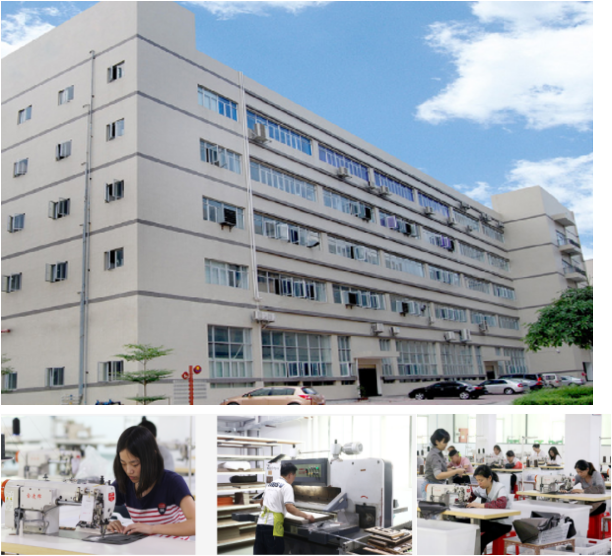
Choosing the best fabric for custom scrunchies is a strategic decision that impacts hair health, brand aesthetics, durability, and sustainability. Silk, satin, and bamboo excel for hair care, offering smoothness and reduced friction. Cotton, velvet, and polyester provide versatility and durability for various use cases, from daily wear to active lifestyles. For eco-conscious brands, Rivta’s bamboo, organic cotton, and recycled polyester deliver sustainable solutions that resonate with modern consumers and align with global environmental goals.
As a trusted manufacturer, Rivta’s factory delivers high-quality, custom scrunchies tailored to your brand’s needs, from wholesale production to eco-friendly branding. Our commitment to sustainability, backed by certifications like Fair Trade and Organic, ensures that your scrunchies not only look good but also reflect your brand’s values. With a 30% reduction in carbon emissions and advanced customization techniques, Rivta is your partner in creating products that stand out in competitive markets.
Explore our sustainable fabric options at Rivta’s website and elevate your promotional campaigns with scrunchies that combine style, function, and environmental responsibility. For custom solutions that meet your brand’s unique requirements—whether you’re a skincare startup or an established beauty empire—contact Rivta today.
